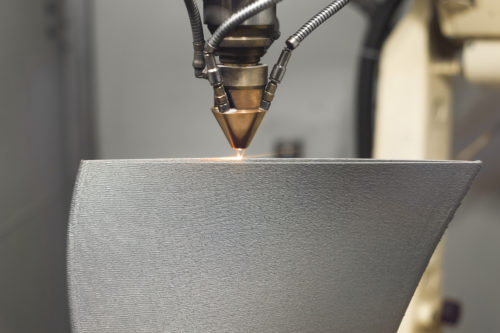What Is Additive Manufacturing?
Leave a CommentAdditive manufacturing is the process of depositing subsequent layers of material to create three-dimensional parts according to a CAD or digital model. When paired with the right applications, this advanced manufacturing approach can deliver complex, consolidated parts with greater efficiency and repeatability than traditional manufacturing technologies. These benefits make additive manufacturing an ideal solution for creating everything from high-performance aerospace and automotive components to detailed electronic parts and consumer goods.
What is the Process for Additive Manufacturing?

Next, a high-power laser beam is used to melt the powder in select locations based on the digital model. The build platform is then lowered, and the next layer of powder is distributed. The laser beam melts the newly-added layer of material, fusing it to the underlying layer at specified points. This process is repeated until the desired 3D shape is formed.
Advantages of Additive Manufacturing
Additive manufacturing can accommodate virtually any geometry or feature, offering designers the freedom to create complex parts that would be difficult or expensive to achieve using traditional manufacturing approaches. Other advantages include:
Click to expand
- Rapid prototyping. The efficiency and speed of additive manufacturing make it perfect for quickly fabricating prototype models from CAD designs. This provides product designers with the opportunity to rapidly transition from sketches and concepts to a hands-on model that can be evaluated, tested, and refined.
- Weight reduction. With additive manufacturing, the weight of a part can be significantly reduced without sacrificing strength or integrity.
- Reduced lead times. Additive manufacturing allows complex designs that would otherwise require multi-piece assemblies to be produced as single, assembly-free parts. This significantly reduces both lead times and production expenses.
- Minimal waste. With additive manufacturing, the material is methodically added in layers until the final part is formed. This allows for much more controlled and efficient use of materials than with subtractive manufacturing.
- Suitable for small production runs. Additive manufacturing allows parts to be created directly from CAD files, eliminating the need for expensive tooling and time-consuming setups. This makes it quicker and more cost-effective than traditional manufacturing methods for small-batch production runs.
Types of Additive Manufacturing Processes

- Direct metal laser sintering (DMLS). With DMLS, a high-power laser is used to sinter each metal powder layer, melting and fusing the metal particles to one another. This allows for the creation of high-strength parts with exceptional accuracy and smooth, attractive surface features.
- Direct metal laser melting (DMLM) and electron-beam melting (EBM). In contrast to sintering, DMLM and EBM methods completely melt each layer of metal powder during part formation. DMLM uses a laser to perform the melting, whereas EBM uses an electron beam. These methods are well-suited for the fabrication of durable, non-porous parts.
- Stereolithography (SLA). With SLA, a UV laser is selectively aimed into a vat of liquid photopolymer resin, where it induces curing via photopolymerization. Subsequent layers are cured until the final 3D part is formed.
Learn more about stereolithography and Chaparral Technology’s other 3D printing services on our capability page.
What Materials are Used in Additive Manufacturing?
The additive manufacturing process is compatible with a wide range of materials, including:
- Thermoplastics. With their widespread availability and low cost, thermoplastics are the most widely used material in additive manufacturing. While acrylonitrile butadiene styrene (ABS) is the most versatile and popular choice, other thermoplastics such as polylactic acid (PLA), polycarbonate (PC), and polyvinyl alcohol (PVA) can be used to meet various application- and industry-specific material requirements.
- Metals. Powdered forms of pure metals and alloys can be used in the additive manufacturing process to create high-strength metal parts with various unique functional and aesthetic properties. Some of the most common metal options include titanium, steel, stainless steel, aluminum, and nickel.
- Naturally-derived materials. In addition to thermoplastics and metals, additive manufacturing is compatible with a range of biological and biochemical materials. Current research is exploring the use of bio-inks produced from engineered live tissue to develop complex biological structures and bioimplants.
- Ceramics. Using additive manufacturing, ceramic materials such as aluminum oxide, aluminum nitride, silicon carbide, and zirconia can be melted and combined in various ways to create products with specific thermal and mechanical properties.
Additive Manufacturing Applications in Industries
With its unparalleled design flexibility and material compatibility, the additive manufacturing process helps drive innovation and growth in several key industries. Examples include:
- Aerospace. Additive manufacturing uses a range of high-performance materials to create strong, lightweight components that can accommodate the tough performance standards and operating conditions encountered in the aerospace industry.
- Transportation. In the transportation industry, additive manufacturing is used to produce exhaust pipes, bumpers, and other automotive structures that are strong enough to pass rigorous safety tests yet lightweight enough to support the trend toward lighter, more energy-efficient vehicles.
- Medical. The fast-paced medical industry uses additive manufacturing to create everything from realistic prototypes and anatomical models to surgical-grade medical components and life-saving devices. Additive manufacturing also offers significant potential for creating personalized implants and prosthetics with organic surface structures that would be difficult or impossible to produce through traditional manufacturing methods.
- Product development. Additive manufacturing gives product developers the freedom to rapidly produce and evaluate numerous design iterations, allowing them to optimize and finalize products more quickly than with traditional manufacturing.
Additive Manufacturing Capabilities at Chaparral Technologies
Chaparral Technologies is a manufacturer’s representative agency with advanced additive manufacturing capabilities to support clients from a wide range of industries. Established in 1968, we are constantly upgrading and refining our processes and policies to provide companies with innovative mechanical components that are optimized to withstand some of the toughest operating environments. To learn more about our additive manufacturing capabilities and other services, please contact us today.

